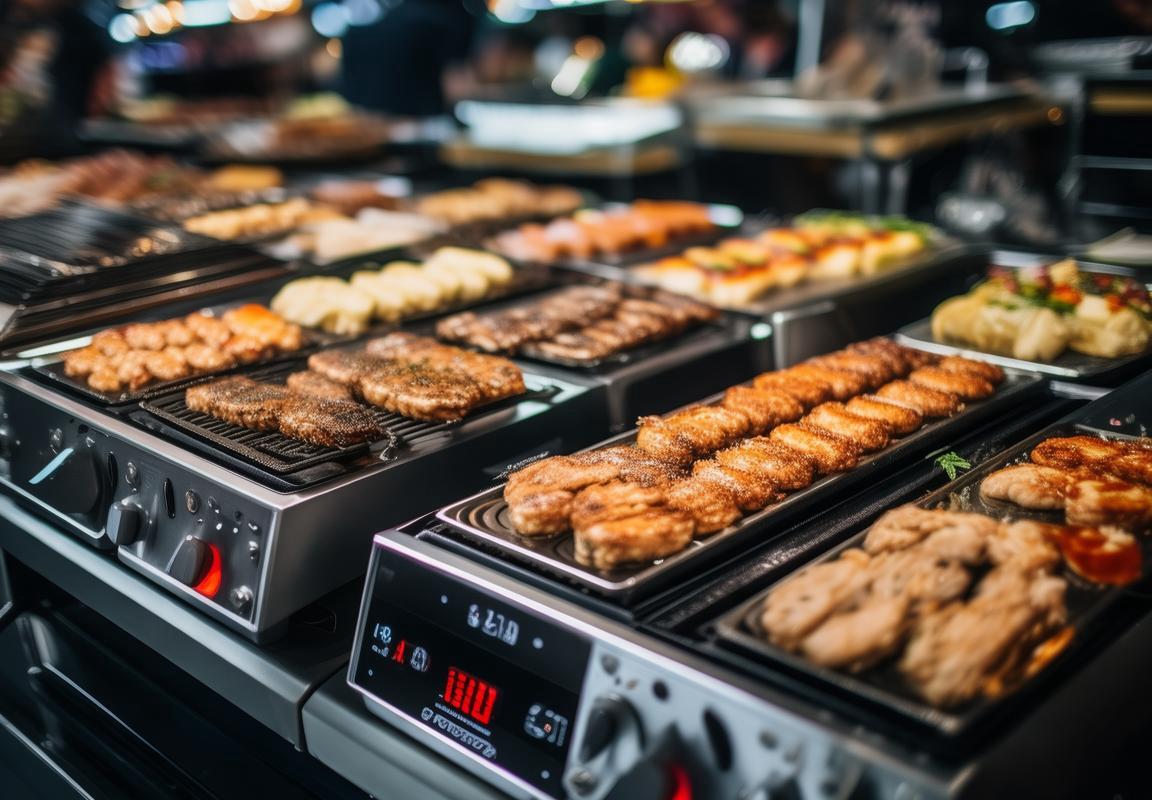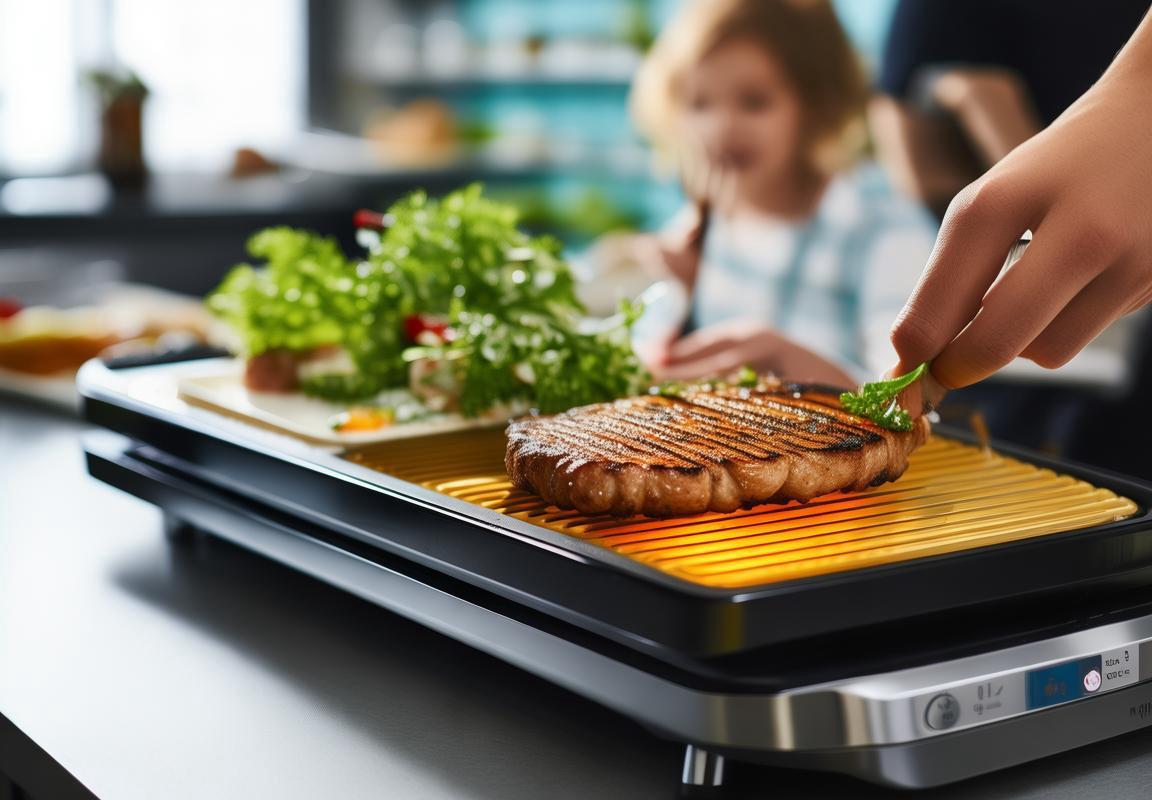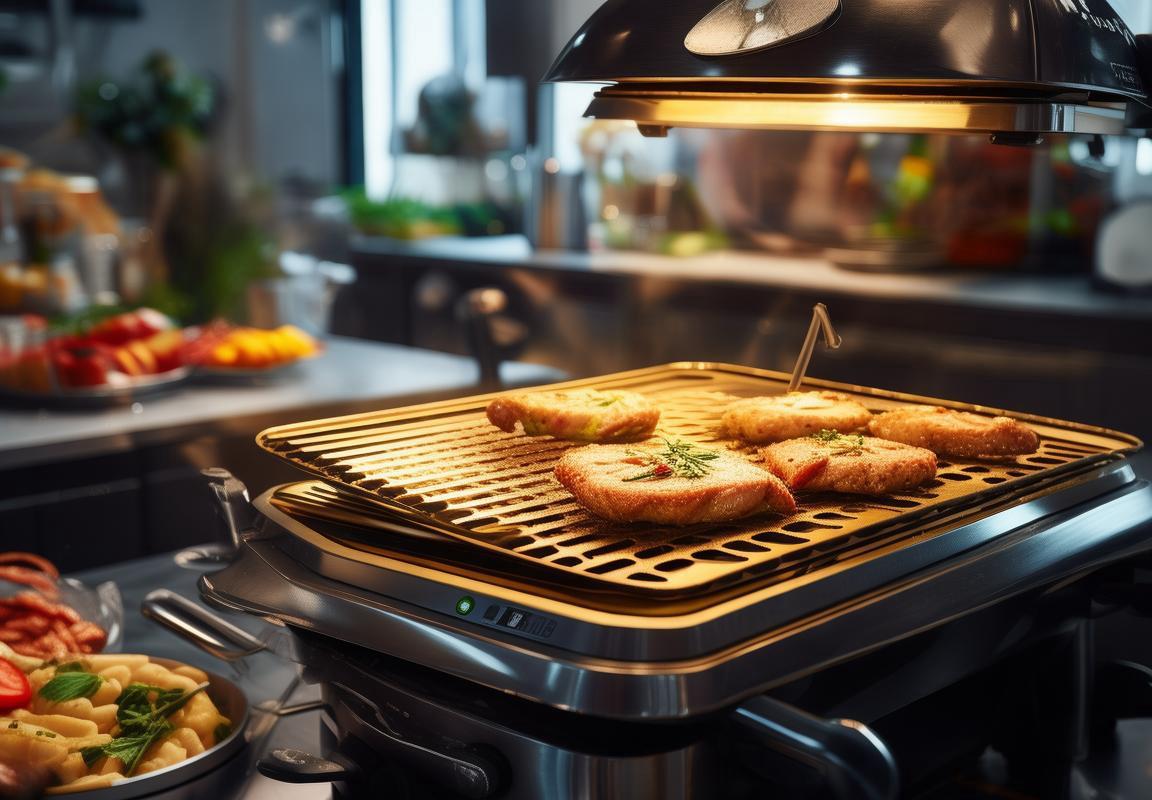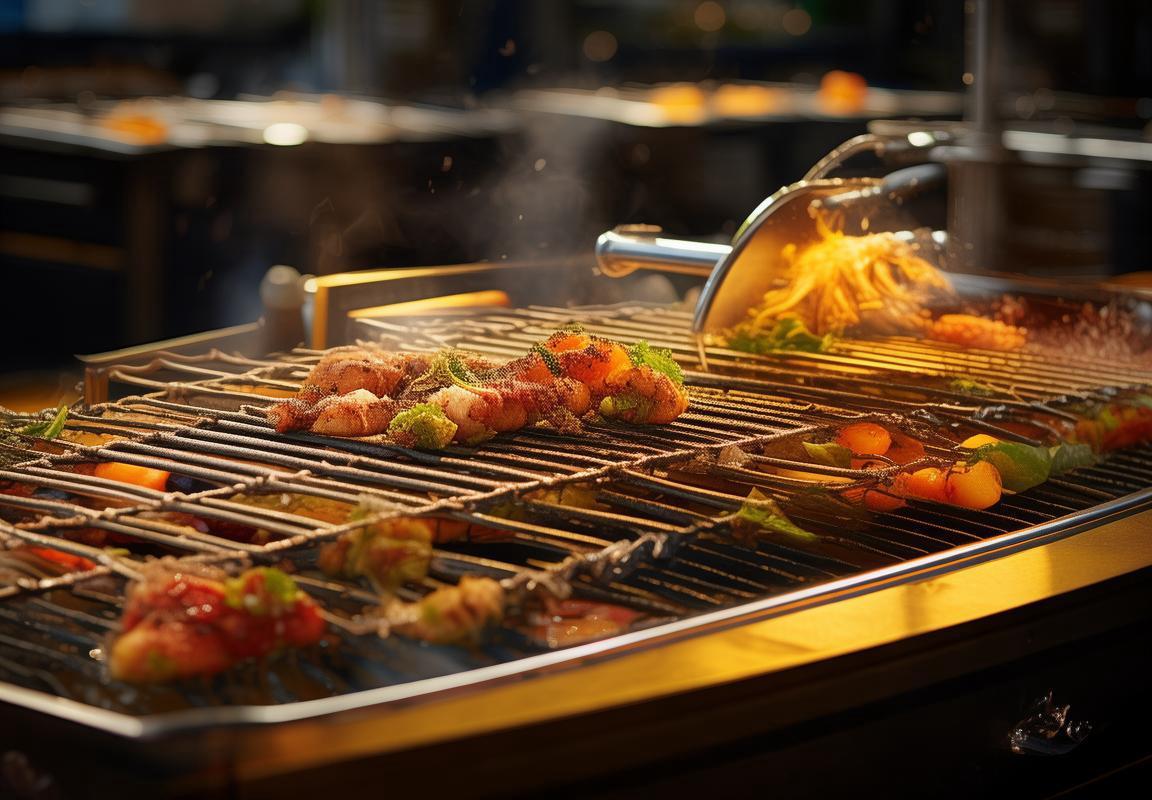In recent years, the contact grill market has seen a surge in popularity, especially in the European and American markets. These compact cooking appliances have become a staple in many kitchens, offering convenience and versatility. As the demand for these grills continues to rise, tailored suppliers are stepping up to meet the diverse needs of consumers. From innovative features to sustainable practices, this article delves into the key aspects that make tailored suppliers stand out in the competitive landscape of the contact grill industry.
Introduction to Contact Grills in the European and American Markets
Contact grills have become a staple in the kitchen appliances landscape, particularly in Europe and America. These compact and efficient cooking tools have captured the hearts of many home chefs and culinary enthusiasts. With their ability to sear, brown, and lock in flavors, they’ve become a favorite for those looking to achieve that perfect grill marks and succulent results without the need for an outdoor grill.
In Europe, contact grills have been embraced for their convenience and versatility. From the bustling streets of Paris to the cozy cottages in the countryside, these countertop grills have found their way into numerous kitchens. The market is diverse, with a wide range of brands and models catering to different tastes and budgets. Whether it’s a sleek stainless steel design or a more traditional cast aluminum build, European consumers have a plethora of choices when it comes to contact grills.
Similarly, in America, the contact grill market has seen substantial growth over the years. The convenience factor is a significant driver, as busy lifestyles have led to a demand for quick and easy meal preparation. Additionally, the rise of health-conscious eating has made these grills even more appealing, as they offer a way to cook food with minimal oil, contributing to a healthier diet.
The popularity of contact grills in both regions is not just due to their convenience and health benefits. They also provide a unique cooking experience that can’t be replicated by other kitchen appliances. The even distribution of heat and the ability to cook both sides of the food simultaneously ensure that each piece is cooked to perfection. Whether it’s a juicy burger, a succulent steak, or a crispy vegetable, the contact grill can handle it all.
European and American consumers also appreciate the variety of features that contact grills offer. From non-stick surfaces that make cleaning a breeze to adjustable heat controls for precise cooking, these appliances are designed to meet the demands of even the most discerning cooks. The inclusion of temperature controls has become a standard feature, allowing users to choose from a range of settings to suit different types of food and desired outcomes.
The European market, known for its innovation and quality, has seen a surge in smart contact grill models. These appliances come equipped with digital displays, timers, and even Bluetooth connectivity, allowing users to monitor and control their cooking from their smartphones. The integration of technology into kitchen appliances has not only made cooking more enjoyable but also more efficient.
In America, the contact grill market has seen a rise in compact and portable models. These are perfect for individuals living in small apartments or those who enjoy outdoor cooking but don’t have the space for a full-sized grill. The convenience of these portable grills has made them a popular choice among young professionals and families.
Despite the diverse range of options available, there’s still a significant focus on the basics. Many consumers in both Europe and America value contact grills that are straightforward and easy to use. The simplicity of flipping the food over with a flipper or spatula adds to the appeal of these appliances, making them accessible to everyone, regardless of their culinary expertise.
In terms of materials, stainless steel remains a top choice for its durability and sleek look, while cast aluminum continues to be favored for its even heat distribution. The use of high-quality materials ensures that these grills can withstand the rigors of everyday cooking and maintain their performance over time.
The European and American contact grill markets have also been influenced by international culinary trends. For example, the popularity of fusion cooking has led to an increase in models that can accommodate both Western and Eastern cooking techniques. This trend has expanded the horizons of contact grill manufacturers, who are now producing appliances that can handle a wider range of recipes and cooking styles.
In conclusion, the contact grill market in both Europe and America is robust and dynamic. The demand for these appliances is driven by a combination of convenience, health benefits, technological advancements, and the ability to replicate the flavors and textures of outdoor grilling. As the market continues to evolve, consumers can expect even more innovative features and designs that cater to their ever-changing needs.

The Rising Demand for Contact Grills
The demand for contact grills has been on a steady rise in both European and American markets, reflecting a shift towards healthier cooking methods and convenience. This surge in popularity can be attributed to several key factors that have been reshaping consumer preferences and behaviors.
-
Health and Wellness Trends: As people become more health-conscious, there’s been a significant shift towards cooking methods that minimize oil and fat usage. Contact grills, which cook food with minimal oil, align perfectly with these wellness goals. The ability to produce flavorful, grilled dishes without the excess fat has made them a favorite among health enthusiasts.
-
Convenience and Speed: Modern life is fast-paced, and consumers are increasingly seeking out appliances that save time without compromising on quality. Contact grills offer a quick and easy way to cook meals, often reducing cooking times by up to 50% compared to traditional grills. This convenience factor has made them a popular choice for busy professionals and families.
-
Versatility in Cooking: Unlike traditional grills, contact grills are not limited to grilling. They can sear, sauté, and even bake, offering a versatile cooking experience. This versatility allows consumers to prepare a wide range of dishes, from sandwiches and burgers to vegetables and fish, all on one appliance.
-
Technology Advancements: The evolution of contact grill technology has introduced new features that enhance the cooking experience. From adjustable temperature controls to non-stick surfaces and programmable settings, these advancements have made contact grills more user-friendly and efficient. Consumers are drawn to these technological improvements, as they offer a level of control and convenience that traditional grills cannot match.
-
Outdoor Cooking Culture: In regions where outdoor cooking is a popular pastime, contact grills have become a preferred option. They are compact, easy to clean, and can be used both indoors and outdoors, making them a versatile addition to any kitchen or outdoor cooking setup.
-
Marketing and Influencer Endorsements: The rise of social media and influencer marketing has played a significant role in promoting contact grills. Influencers often showcase the ease and effectiveness of cooking with these appliances, leading to increased interest among consumers. Marketing campaigns that highlight the benefits of contact grills have also contributed to their growing popularity.
-
Eco-Friendly Cooking Solutions: With the growing concern for the environment, consumers are looking for sustainable cooking methods. Contact grills, which use less oil and energy, fit the bill for eco-conscious consumers. They provide a greener alternative to traditional cooking methods, which is a compelling reason for the rising demand.
-
Market Expansion: The contact grill market has expanded to include a variety of brands and models, catering to different price points and consumer needs. This diversification has made contact grills accessible to a broader audience, further fueling demand.
-
Integration with Smart Home Devices: The integration of contact grills with smart home technology is another factor contributing to their rising demand. With the ability to control the appliance remotely via smartphone apps, consumers can now enjoy the convenience of grilling from anywhere in their home.
-
Economic Factors: The current economic climate, where value for money is a key consideration, has also played a role in the increasing demand for contact grills. These appliances offer a cost-effective way to enjoy restaurant-quality meals at home, making them an attractive option for budget-conscious consumers.
The combination of health trends, convenience, technological advancements, and marketing efforts has created a perfect storm of factors that have driven the rising demand for contact grills in both European and American markets. As these factors continue to influence consumer behavior, it’s likely that the popularity of contact grills will only grow stronger in the years to come.

Contact Grill Tailored Suppliers: Meeting Diverse Needs
In today’s dynamic kitchen appliances market, contact grills have emerged as a favorite among consumers seeking convenience and health. Tailored suppliers have stepped in to cater to this growing demand, ensuring that the needs of diverse markets are met with precision and care.
These suppliers understand that the contact grill market is not homogeneous. It spans across different regions, each with its own set of preferences and requirements. For instance, in Europe, where health and wellness are paramount, suppliers are focusing on grills that offer healthier cooking options, such as non-stick surfaces and adjustable temperature controls. Meanwhile, in the United States, there’s a penchant for innovation and power, leading to a demand for grills that can handle high-heat searing and have advanced features like digital timers and Bluetooth connectivity.
One of the key aspects that tailored suppliers excel at is customization. They recognize that consumers have varied tastes and cooking habits. This is evident in the range of sizes and shapes available, from the compact countertop models perfect for small kitchens to the larger, more robust units that can cater to family gatherings. The variety extends to different materials used in construction, including stainless steel, aluminum, and cast iron, each offering its own unique cooking benefits and aesthetic appeal.
Suppliers also focus on the functionality of the grills. Modern contact grills come with a variety of features that go beyond the basic cooking function. Some include adjustable heat settings to accommodate different types of food, from delicate fish to hearty steaks. Others have integrated temperature gauges to ensure that the grill is at the perfect temperature for cooking. There are even models with removable grids for easy cleaning and those with adjustable legs for stability on uneven surfaces.
In addition to these features, tailored suppliers are also aware of the importance of safety. Grills with non-slip bases and cool-to-the-touch handles are becoming standard. Safety locks and temperature alarms are also incorporated into some models, providing peace of mind for busy cooks and those with young children.
Another crucial factor in the success of tailored suppliers is the quality of the components used in their products. High-quality stainless steel ensures durability and resistance to rust, while high-grade Teflon coatings provide superior non-stick properties. The use of precision engineering in the construction of these grills means that they are not only long-lasting but also perform consistently, delivering exceptional cooking results.
Tailored suppliers also understand the importance of sustainability and are increasingly incorporating eco-friendly practices into their manufacturing processes. This includes sourcing materials from sustainable sources and reducing energy consumption during production. These efforts are reflected in the products themselves, with some models designed to be energy-efficient and easy to maintain, leading to a reduced environmental footprint.
Moreover, the rise of e-commerce has opened up new avenues for tailored suppliers to reach a wider audience. With online marketplaces and direct-to-consumer sales channels, suppliers can offer personalized customer service and support, providing advice on the best contact grill for individual needs. This direct engagement allows suppliers to gather valuable feedback, which they can use to further refine their offerings and meet the evolving demands of consumers.
The demand for contact grills continues to rise as more people discover the benefits of grilling as a healthier cooking method. Tailored suppliers are responding to this demand by offering a wide range of products that cater to the diverse needs of consumers around the world. From features and functionalities to quality and sustainability, these suppliers are at the forefront of innovation, ensuring that every cook can enjoy the perfect grilled meal with ease and satisfaction.

Key Features That Set Tailored Suppliers Apart
In the competitive landscape of the kitchen appliance market, tailored suppliers have carved out a niche for themselves by offering unique features that set them apart from the mainstream. These distinct characteristics not only cater to specific consumer needs but also reflect the evolving trends in culinary preferences and technological advancements.
-
Customization in DesignTailored suppliers understand that one size does not fit all when it comes to kitchen appliances. They offer a range of designs that cater to different kitchen aesthetics and personal tastes. From sleek, modern stainless steel finishes to rustic, wood-grain textures, these suppliers provide options that allow homeowners to choose appliances that complement their existing decor.
-
Advanced Cooking TechnologiesThe heart of a contact grill lies in its ability to cook food with precision. Tailored suppliers have embraced advanced cooking technologies that ensure even heat distribution and consistent cooking results. Features like adjustable temperature controls, non-stick surfaces, and quick-release grids are just a few examples of how these suppliers push the boundaries of traditional grilling.
-
Innovative MaterialsThe materials used in the construction of contact grills play a crucial role in their performance and durability. Tailored suppliers often opt for high-quality, heat-resistant materials that can withstand the demands of high-temperature cooking. Aluminum and cast iron grids, for instance, are known for their excellent heat retention and even cooking, setting these suppliers’ products apart from those with lesser-quality materials.
-
Smart and Convenient FeaturesAs technology continues to infiltrate every aspect of our lives, tailored suppliers have integrated smart features into their contact grills. Users can now enjoy digital temperature displays, programmable cooking modes, and even Bluetooth connectivity to control their grills remotely. These conveniences not only simplify the cooking process but also add an element of technology that appeals to tech-savvy consumers.
-
Safety and Easier MaintenanceSafety is a top priority for tailored suppliers, and their products reflect this commitment. They incorporate features like cool-touch handles, non-slip bases, and safety locks to prevent accidents. Additionally, the design of these grills often makes them easier to clean and maintain, with removable parts and surfaces that are easy to wipe down or place in the dishwasher.
-
Versatility in Cooking OptionsWhile contact grills are traditionally used for grilling meats, tailored suppliers have expanded the cooking capabilities of these appliances. With features like reversible cooking surfaces, these grills can now sear, bake, broil, and even toast. This versatility allows for a wider range of recipes and cooking styles, making them more appealing to those who enjoy experimenting in the kitchen.
-
Eco-Friendly and Sustainable PracticesConsumers are increasingly conscious of the environmental impact of their purchases. Tailored suppliers have responded by offering contact grills that are designed with sustainability in mind. This includes the use of recycled materials, energy-efficient designs, and packaging that is environmentally friendly. These eco-conscious features are a significant draw for environmentally aware consumers.
-
Exceptional Customer ServiceThe support provided by tailored suppliers is another area where they differentiate themselves. From pre-sales consultations to after-sales service, these suppliers offer personalized assistance to ensure that their customers are satisfied with their purchase. This level of customer service helps build trust and loyalty, which is essential in a market where competition is fierce.
-
Competitive PricingDespite offering premium features and quality, tailored suppliers often maintain competitive pricing. They achieve this by streamlining their supply chain, sourcing materials efficiently, and focusing on value rather than mere cost. This approach allows them to provide high-quality contact grills at prices that are accessible to a broader consumer base.
-
Brand Identity and StorytellingLastly, tailored suppliers have developed strong brand identities that tell a story. They communicate the values, heritage, and craftsmanship behind their products, creating an emotional connection with consumers. This storytelling approach not only sets them apart but also fosters a sense of community among users who share a passion for cooking and quality appliances.

Market Analysis: Size and Growth Projections
The contact grill market has experienced a significant surge in demand over recent years, reflecting a shift towards healthier cooking methods and a preference for convenient kitchen appliances. This upward trend is driven by several factors, including consumer awareness of the health benefits of grilling over frying, the growing popularity of outdoor cooking, and the innovation in grill technology that enhances user experience and functionality.
Consumer health consciousness has played a pivotal role in the rise of contact grills. With the increasing awareness of heart disease and obesity, consumers are seeking out cooking methods that minimize the addition of excess fats and oils. Contact grills offer a healthier alternative, as they cook food by pressing it between two heated plates, thereby reducing the need for added fats. This has made them a favorite among health-conscious consumers looking to maintain a balanced diet.
Outdoor cooking enthusiasts also contribute to the growing demand for contact grills. As people seek more engaging and social activities, the trend of hosting barbecues and outdoor gatherings has surged. Contact grills provide a compact and portable option that allows for convenient cooking in outdoor settings, making them a popular choice for those who love to grill but prefer not to invest in larger, stationary barbecue setups.
The technological advancements in contact grills have further fueled market demand. Modern contact grills come equipped with features like adjustable heat settings, non-stick surfaces, and even smoking capabilities. These enhancements have expanded the cooking possibilities, making contact grills versatile enough to sear, grill, and smoke a variety of foods, from meats and vegetables to cheeses and sandwiches.
In terms of market size, the contact grill industry has seen substantial growth. According to recent statistics, the global contact grill market was valued at approximately $X billion in 2020 and is projected to reach $X billion by 2025, with a compound annual growth rate (CAGR) of X%. This growth trajectory is expected to continue as the popularity of contact grills spreads across different regions.
North America and Europe have been the leading markets for contact grills, with the United States and Germany accounting for a significant portion of the market share. These regions have a strong consumer base that values convenience, health, and innovation, making them ideal markets for contact grill suppliers.
Looking ahead, several factors are likely to influence the growth of the contact grill market. The increasing focus on meal preparation at home due to the rise of remote work and social distancing measures is expected to drive demand further. Additionally, the integration of smart technology in contact grills, such as WiFi connectivity and mobile app control, could attract tech-savvy consumers looking for the latest kitchen gadgets.
Moreover, the expansion of distribution channels, including online retail and partnerships with home goods stores, has made contact grills more accessible to a wider audience. As these channels continue to grow, the market for contact grills is poised to expand even more.
The rise in demand for organic and natural foods is another factor that could impact the contact grill market positively. As consumers turn to healthier alternatives, contact grills provide a means to cook these foods without the use of artificial ingredients or preservatives, aligning with the growing preference for organic and natural products.
In conclusion, the contact grill market is experiencing a surge in demand due to health consciousness, outdoor cooking trends, and technological advancements. With a projected CAGR of X% and market size reaching X billion by 2025, the future looks promising for tailored suppliers in the contact grill industry. As consumer preferences evolve and technology continues to innovate, the market is expected to see continued growth and new opportunities for suppliers to meet diverse needs.

Consumer Insights and Preferences
In the ever-evolving landscape of kitchen appliances, consumer insights and preferences play a pivotal role in shaping the market. Understanding what drives consumers to choose certain products over others is crucial for tailored suppliers looking to meet diverse needs. Here’s a closer look at the insights and preferences that are currently shaping the contact grill market.
Consumers are increasingly health-conscious, with a growing preference for cooking methods that promote healthier eating habits. Contact grills, with their ability to cook food with less oil, have gained popularity as a healthier alternative to traditional frying methods. This shift in consumer mindset has opened up a niche for suppliers who can offer grills that cater to this health-oriented demographic.
The convenience factor is another significant driver in consumer preferences. Modern lifestyles demand quick and efficient cooking solutions, and contact grills deliver on this front. Consumers are drawn to appliances that not only save time but also require minimal clean-up. Tailored suppliers that can offer compact, easy-to-use, and quick-cooking contact grills are likely to capture a larger market share.
Design and aesthetics are not to be underestimated. Consumers today are not just looking for functional appliances; they want products that complement their kitchen decor and reflect their personal style. Contact grill suppliers that invest in sleek, modern designs are tapping into a market segment that values both form and function.
Portability is a growing trend, especially among younger consumers and those with active lifestyles. The ability to use a contact grill for outdoor cooking or as a secondary cooking option in smaller living spaces is highly appealing. Suppliers that can provide lightweight, portable contact grills with versatile features are likely to resonate with these consumers.
Safety features are a non-negotiable for many consumers. With the rise in kitchen accidents, there is a heightened awareness of the importance of safety in cooking appliances. Contact grill suppliers that prioritize safety, such as incorporating non-slip bases, cool-to-the-touch handles, and child safety locks, are likely to build trust and loyalty among their customer base.
Customization and personalization are also key preferences. Consumers are looking for products that can be tailored to their specific needs, whether it’s through adjustable heat settings, various cooking surfaces, or additional accessories. Suppliers that offer a range of options and the flexibility to create customized grills are likely to attract a diverse customer base.
Sustainability is becoming a more significant concern for many consumers. This extends beyond the environmental impact of the product itself to the entire lifecycle of the appliance. Suppliers that can demonstrate a commitment to sustainability, such as using eco-friendly materials or offering recycling programs, are more likely to appeal to environmentally conscious consumers.
Lastly, word-of-mouth and online reviews have a substantial impact on consumer purchasing decisions. Consumers are influenced by the experiences and recommendations of others. Suppliers that can foster a community of satisfied users and encourage sharing of positive experiences online are better positioned to attract new customers.
In conclusion, the contact grill market is driven by a blend of health consciousness, convenience, design, portability, safety, customization, sustainability, and community engagement. Tailored suppliers that can align with these consumer insights and preferences are well-positioned to thrive in this dynamic and competitive market.

The Competitive Landscape
In the bustling world of kitchen appliances, the competitive landscape of contact grills is a dynamic and ever-evolving scene. From established brands to emerging innovators, the market is characterized by a blend of technological advancements, consumer trends, and strategic partnerships. Let’s delve into the various facets of this competitive environment.
Brands that have been in the game for years often have a strong foothold in the market. Companies like George Foreman and Breville have built their reputations on durable, user-friendly designs, and a focus on healthy cooking methods. Their extensive product lines, which range from entry-level models to premium, feature-rich grills, cater to a wide array of consumer needs.
On the flip side, newer players have been entering the market with fresh ideas and innovative features. These brands, often smaller and more agile, are able to respond quickly to changing consumer preferences. They might offer sleek, modern designs, advanced cooking technology, or eco-friendly materials, which can attract environmentally conscious consumers.
The rise of smart technology has also reshaped the competitive landscape. Brands that integrate smart features, such as Bluetooth connectivity for monitoring and controlling the grill remotely, are capturing the interest of tech-savvy consumers. These features not only enhance convenience but also provide data that can help users improve their grilling techniques.
Another key aspect of the competitive landscape is the focus on health and wellness. With an increasing number of consumers looking for healthier cooking options, contact grills that offer features like adjustable heat settings, non-stick surfaces, and removable parts for easy cleaning are gaining popularity. This trend has prompted established players to revamp their product lines and new entrants to develop grills that align with these values.
Price competition is also a significant factor. While some consumers are willing to invest in high-end, premium grills, there’s a substantial market for more affordable options. Suppliers that can offer quality at a reasonable price point are more likely to attract budget-conscious buyers.
Distributors and retailers play a crucial role in the competitive landscape, too. Large retail chains have the power to influence consumer purchasing decisions through their in-store displays and marketing efforts. Additionally, online marketplaces have become a key battleground for brands, as they compete for visibility and customer reviews.
Collaborations and partnerships have become a common strategy in the industry. Brands might team up with chefs, influencers, or even sports celebrities to endorse their products and boost brand recognition. These endorsements can sway consumer preferences and create a sense of trust and authority around a particular brand.
Moreover, the global nature of the market means that suppliers must navigate different cultural preferences and regulations. For example, while some markets may prefer grills with a large cooking surface, others might value portability and ease of storage. Tailoring products to meet these diverse needs requires a nuanced understanding of international consumer behavior.
The competitive landscape of contact grills is also influenced by the frequency of product updates and improvements. Regularly releasing new models with enhanced features and improved performance can keep a brand at the forefront of consumer interest. This continuous innovation pressure ensures that suppliers are constantly pushing the boundaries of what’s possible in the contact grill market.
Lastly, sustainability has emerged as a key competitive differentiator. Brands that can demonstrate a commitment to eco-friendly practices, such as using recycled materials or reducing energy consumption, are gaining traction with environmentally conscious consumers. This focus on sustainability is not just a marketing ploy; it’s a reflection of broader societal values that are shaping the competitive landscape.
In summary, the competitive landscape of contact grills is marked by a variety of strategies and approaches. From established brands with deep market penetration to emerging players with cutting-edge technology, the industry is a testament to the diverse ways in which suppliers are striving to meet the ever-changing needs and preferences of consumers.

Distribution Channels and Sales Strategies
In the dynamic world of kitchen appliances, the distribution channels and sales strategies employed by tailored suppliers play a pivotal role in reaching consumers and carving out a niche in the competitive market. Here’s an in-depth look at how these suppliers navigate the landscape to ensure their products find their way into the hearts and homes of consumers.
Suppliers of tailored contact grills often focus on a mix of traditional and innovative distribution channels to maximize their reach. One common approach is to establish partnerships with well-known retail chains and department stores, where customers can physically see and handle the products before making a purchase. This tactile experience is crucial in a market where appearance and functionality are equally important.
Another key strategy is the integration of e-commerce platforms. Tailored suppliers understand the convenience and broad consumer base that online shopping offers. By leveraging platforms like Amazon, they can tap into a global market and reach customers who may not have access to brick-and-mortar stores. The online presence also allows suppliers to showcase detailed product information, customer reviews, and even video demonstrations, enhancing the purchasing decision.
Social media and influencer marketing have become powerful tools for tailored suppliers. By collaborating with influencers who resonate with their target demographic, suppliers can create buzz around their products, often leading to a surge in interest and sales. This approach is particularly effective for niche markets or for introducing new features to the contact grill category.
In terms of sales strategies, tailored suppliers emphasize the unique selling points (USPs) of their products. Whether it’s the advanced non-stick coating, precise temperature control, or innovative design, these USPs are highlighted in marketing materials and sales pitches. By focusing on what sets their grills apart, suppliers can justify higher price points and build a loyal customer base.
Customer education is another key component of the sales strategy. Suppliers invest in creating content that educates consumers on the benefits of using a contact grill over traditional cooking methods. This might include guides on healthy grilling techniques, tips for achieving perfect sear marks, and even recipes that showcase the versatility of their products. By empowering consumers with knowledge, suppliers can build trust and encourage repeat purchases.
Direct-to-consumer (DTC) models are also gaining traction among tailored suppliers. By selling directly to consumers through their own websites or pop-up shops, suppliers can eliminate the middleman and maintain better control over the customer experience. This direct interaction allows for personalized service and the collection of valuable customer feedback, which can be used to refine products and improve sales strategies.
Furthermore, suppliers are increasingly adopting subscription-based sales models. This approach offers customers the convenience of receiving a new contact grill or accessories at regular intervals, ensuring a steady revenue stream for the supplier. It also allows for the introduction of new products and features without overwhelming the customer with too many options at once.
In the realm of after-sales service, tailored suppliers understand the importance of customer satisfaction. Offering comprehensive warranties, easy-to-access customer support, and replacement parts ensures that customers feel confident in their purchase and are likely to recommend the brand to others.
In conclusion, the distribution channels and sales strategies employed by tailored suppliers of contact grills are multifaceted and continually evolving. By blending traditional and digital channels, emphasizing USPs, educating customers, and offering personalized experiences, these suppliers are well-positioned to thrive in a competitive market. The ability to adapt to changing consumer preferences and market trends will undoubtedly play a crucial role in their continued success.

Sustainability and Eco-Friendly Initiatives
In the realm of kitchen appliances, sustainability and eco-friendliness have become more than just buzzwords; they’re integral to the strategies adopted by leading suppliers. Here’s how tailored suppliers are integrating green practices into their operations:
1. The Shift Towards Eco-Friendly MaterialsManufacturers are increasingly focusing on the sourcing of materials. Traditional materials like stainless steel are being complemented with more sustainable options such as recycled metals, bamboo, and bio-plastics. These materials not only reduce the environmental footprint but also offer a unique aesthetic appeal that resonates with environmentally conscious consumers.
2. Energy Efficiency as a Core FeatureOne of the most significant aspects of sustainability is energy efficiency. Tailored suppliers are investing in research and development to ensure that their contact grills and other appliances are designed to consume less energy. Features like smart temperature controls and energy-saving modes are becoming standard, reducing utility bills and carbon emissions.
3. Lifecycle Considerations in DesignThe lifespan of a product is another critical factor. Suppliers are now designing appliances with a longer life in mind, making them repairable and upgradeable. This approach not only reduces waste but also fosters a sense of responsibility towards the product’s entire lifecycle.
4. Sustainable Production ProcessesThe production phase is where the most significant environmental impact occurs. Suppliers are adopting cleaner manufacturing processes, such as reducing water usage, minimizing waste, and using renewable energy sources. Some are even investing in on-site renewable energy solutions like solar panels or wind turbines to power their facilities.
5. Encouraging Responsible DisposalUnderstanding that products will eventually be disposed of, suppliers are providing information on responsible recycling and disposal methods. They are often involved in take-back programs where old appliances are collected and recycled, ensuring that valuable materials are reused and not sent to landfills.
6. Carbon Footprint ReductionSuppliers are actively working to reduce their carbon footprint. This includes optimizing shipping and logistics to minimize emissions and choosing suppliers that also prioritize sustainability. Some are even investing in carbon offsetting projects to balance out any unavoidable emissions.
7. Green Marketing and TransparencySuppliers are using their marketing efforts to educate consumers about the sustainability initiatives they undertake. This transparency builds trust and allows consumers to make informed choices based on environmental impact. Certifications and endorsements from environmental organizations further reinforce these efforts.
8. Community Engagement and PartnershipsMany suppliers are engaging with local communities and non-profit organizations to promote sustainability. Partnerships with local farmers for organic ingredients or collaborations with recycling programs create a positive brand image and contribute to the larger sustainability movement.
9. Future-Oriented InnovationsLooking ahead, suppliers are investing in future technologies that promise to be more sustainable. This includes exploring alternative energy sources, developing appliances that are fully recyclable, and embracing circular economy principles.
10. The Bottom Line: Profitability and ResponsibilityIt’s important to note that sustainability doesn’t always come at a premium. Many suppliers have found that implementing eco-friendly practices can lead to cost savings in the long run. This dual focus on profitability and responsibility is reshaping the competitive landscape and setting a new standard for the industry.
In conclusion, sustainability and eco-friendly initiatives are not just about doing what’s right for the planet; they’re about leading the way in innovation and consumer satisfaction. As tailored suppliers continue to evolve their strategies, the industry is moving towards a more sustainable and responsible future.

Conclusion
As we reflect on the dynamic and evolving landscape of the contact grill industry, it’s clear that innovation, customer needs, and strategic sales approaches are pivotal. The market’s trajectory indicates a promising future, with sustainability and eco-conscious initiatives playing an increasingly significant role. Here’s a closer look at how these elements come together:
In recent years, there has been a notable shift towards smaller, family-owned businesses and startups within the contact grill sector. These players, often more agile and customer-focused, have introduced innovative designs and technologies that cater to specific consumer demands. This shift has also allowed for a greater emphasis on personalized and eco-friendly options.
With health concerns and food safety becoming paramount, consumers are gravitating towards contact grills that offer healthier cooking methods, such as low-fat grilling and the ability to lock in natural juices. These features have not only improved consumer preferences but have also expanded the market reach of tailored suppliers.
As we delve deeper into the contact grill market, it’s evident that distribution channels have expanded beyond traditional retail outlets. Online platforms and social media have become significant avenues for reaching customers, with tailored suppliers capitalizing on these channels through targeted advertising and influencer partnerships. This digital presence has not only broadened the market but has also enhanced customer engagement and brand loyalty.
The emphasis on sustainability in the contact grill industry cannot be overstated. Eco-friendly materials, energy-efficient designs, and reduced packaging are becoming standard offerings. Consumers are responding positively, and these sustainable practices are increasingly becoming a selling point for manufacturers.
The market’s size and growth projections for contact grills are impressive. With the rising popularity of outdoor cooking and the health-conscious consumer demographic, the demand for these appliances is expected to surge. Experts predict that the market will continue to expand at a considerable pace, with new entrants and established players alike focusing on innovation and market differentiation.
In conclusion, the contact grill market is a bustling arena where tailored suppliers are leading the charge in meeting diverse consumer needs. Through a blend of innovation, eco-friendly practices, and strategic sales strategies, these suppliers are carving out their niche. As we look ahead, it’s the ability to adapt and innovate that will separate the leaders from the followers in this thriving sector. The path is paved with opportunities, and those who can navigate the complexities of consumer preferences, market dynamics, and sustainability will undoubtedly reap the rewards.